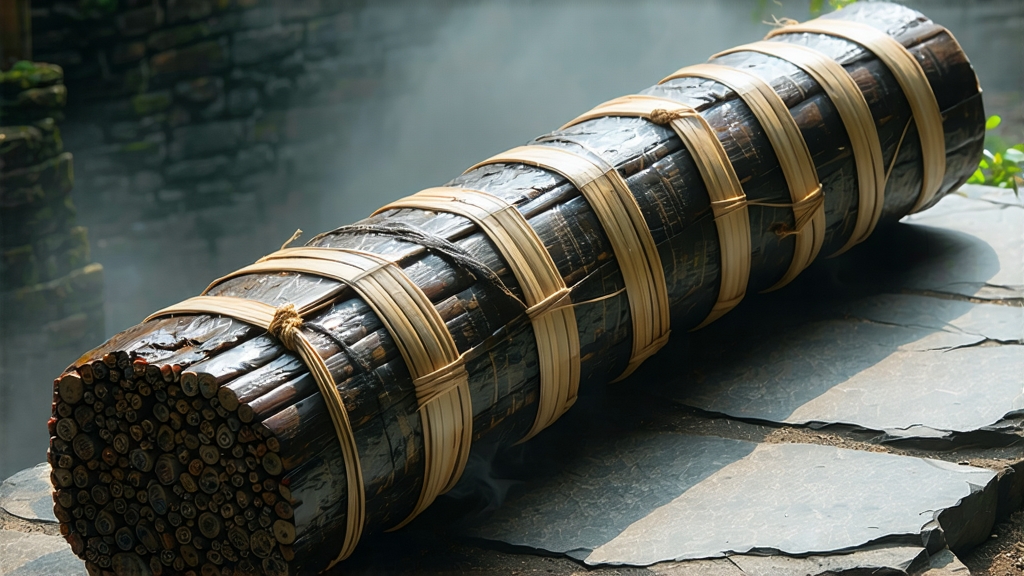
When most tea lovers outside China hear “dark tea,” they picture the mellow, earthy disks of Yunnan Pu-erh. Yet 1,200 km to the northeast, cradled by the misty Xuefeng and Wuling mountains of Hunan province, another dark tea has been quietly fermenting for five centuries. Known as Qianliang Cha—literally “1,000-tael tea”—it is pressed into a colossal, bamboo-sheathed log weighing exactly 36.25 kg (1,000 old Chinese taels). This article invites you to meet the giant of the dark-tea family: its origin myth, microbial alchemy, caravan history, and the ritual of coaxing a velvet liquor from what looks like a wooden missile.
-
From Ming Tax to Qing Caravans: a Brief History
In 1595 the Ming court, desperate for war horses on the northern frontier, decreed that Hunan’s rough green teas could be exchanged for Tibetan steeds. Tea pressed into dense bricks traveled farther without crumbling, so farmers along the Anhua valley began steaming, piling, and compressing their leaves. By the early Qing dynasty the 1,000-tael log format had emerged: easier to lash to pack-saddles, impossible to steal piecemeal, and—thanks to its anaerobic core—able to improve with every league it climbed toward Lhasa. Caravans of 200 mules each carried 40 logs, their bells echoing through gorges now immortalized as the “Ancient Tea-Horse Road.” Qianliang Cha became legal tender in Tibet; monks paid taxes with it, nomads bartered butter and salt, and doctors prescribed it for altitude sickness. -
Terroir and Leaf: the Anhua Advantage
The Fu River, a tributary of the Yangtze, traps humid clouds between granite peaks. The resulting year-round fog filters UV light, forcing tea bushes (predominantly the small-leaf Camellia sinensis var. sinensis “Yun-da” clone) to produce more theanine and less bitter catechins. Spring leaves are picked with one bud and three or four serrated leaves, thicker than those used for green tea but younger than the summer pu-erh standard. The local proverb says, “Anhua cloud tea, three days fragrant,” hinting at the honeyed aroma that survives even post-fermentation. -
Crafting a Giant: the Eight-Step Alchemy
a. Wilting: trays of leaves are stacked in shaded bamboo lofts for 4–6 hours; moisture drops to 68 %.
b. Pan-firing: 280 °C for 90 seconds deactivates polyphenol oxidase, but the leaf is left slightly green at the edges—halfway to green tea yet intentionally under-killed.
c. Rolling: cloth-wrapped bundles are trodden by barefoot workers, twisting cells without rupturing them completely; this preserves microbial substrates.
d. First piling: heaps 1 m high are covered with wet linen; temperature climbs to 55 °C in 24 h. Thermophilic bacteria (Bacillus subtilis, Staphylococcus saprophyticus) bloom, turning leaves ochre and releasing the first waft of wet earth.
e. Second firing: a brief 120 °C pass halts excessive mold, locking in a toasty note.
f. Second piling—The “Golden Flower” phase: leaves are re-stacked inside a heated cellar (28 °C, 75 % RH). Over 15 days Eurotium cristatum forms yellow cleistothecia on leaf surfaces. These “golden flowers” (jin hua) secrete α-amylase and protease, breaking starch into sweet sugars and proteins into umami amino acids.
g. Steaming and compression: the fermented leaf is steamed for 90 seconds, then scooped into long cotton socks. Two men twist the socks like tourniquets, forcing tea into a bamboo cylinder 1.5 m long. A hydraulic press compresses the log to 40 % of its original volume; bamboo straps are tightened with rattan.
h. Curing: logs stand upright in ventilated sheds for 45 days, losing 12 % moisture. During this phase anaerobic yeasts (Pichia fermentans) continue slow fermentation, raising theaflavin levels and mellowing bitterness. The finished log can age for decades